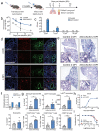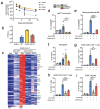This is a preprint.
Mouse model of SARS-CoV-2 reveals inflammatory role of type I interferon signaling
- PMID: 32714125
- PMCID: PMC7366812
- DOI: 10.2139/ssrn.3628297
Mouse model of SARS-CoV-2 reveals inflammatory role of type I interferon signaling
Update in
-
Mouse model of SARS-CoV-2 reveals inflammatory role of type I interferon signaling.J Exp Med. 2020 Dec 7;217(12):e20201241. doi: 10.1084/jem.20201241. J Exp Med. 2020. PMID: 32750141 Free PMC article.
Abstract
Severe Acute Respiratory Syndrome- Coronavirus 2 (SARS-Cov-2) has caused over 5,000,000 cases of Coronavirus disease (COVID-19) with significant fatality rate.1-3 Due to the urgency of this global pandemic, numerous therapeutic and vaccine trials have begun without customary safety and efficacy studies.4 Laboratory mice have been the stalwart of these types of studies; however, they do not support infection by SARS-CoV-2 due to the inability of its spike (S) protein to engage the mouse ortholog of its human entry receptor angiotensin-converting enzyme 2 (hACE2). While hACE2 transgenic mice support infection and pathogenesis,5 these mice are currently limited in availability and are restricted to a single genetic background. Here we report the development of a mouse model of SARS-CoV-2 based on adeno associated virus (AAV)-mediated expression of hACE2. These mice support viral replication and antibody production and exhibit pathologic findings found in COVID-19 patients as well as non-human primate models. Moreover, we show that type I interferons are unable to control SARS-CoV2 replication and drive pathologic responses. Thus, the hACE2-AAV mouse model enables rapid deployment for in-depth analysis following robust SARS-CoV-2 infection with authentic patient-derived virus in mice of diverse genetic backgrounds. This represents a much-needed platform for rapidly testing prophylactic and therapeutic strategies to combat COVID-19.
Conflict of interest statement
Competing Interests None of the authors declare interests related to the manuscript.
Figures






Similar articles
-
Mouse model of SARS-CoV-2 reveals inflammatory role of type I interferon signaling.bioRxiv [Preprint]. 2020 May 27:2020.05.27.118893. doi: 10.1101/2020.05.27.118893. bioRxiv. 2020. Update in: J Exp Med. 2020 Dec 7;217(12):e20201241. doi: 10.1084/jem.20201241. PMID: 32577647 Free PMC article. Updated. Preprint.
-
Mouse model of SARS-CoV-2 reveals inflammatory role of type I interferon signaling.J Exp Med. 2020 Dec 7;217(12):e20201241. doi: 10.1084/jem.20201241. J Exp Med. 2020. PMID: 32750141 Free PMC article.
-
SARS-CoV-2 Causes Lung Infection without Severe Disease in Human ACE2 Knock-In Mice.J Virol. 2022 Jan 12;96(1):e0151121. doi: 10.1128/JVI.01511-21. Epub 2021 Oct 20. J Virol. 2022. PMID: 34668780 Free PMC article.
-
K18- and CAG-hACE2 Transgenic Mouse Models and SARS-CoV-2: Implications for Neurodegeneration Research.Molecules. 2022 Jun 28;27(13):4142. doi: 10.3390/molecules27134142. Molecules. 2022. PMID: 35807384 Free PMC article. Review.
-
SARS-CoV replication and pathogenesis in an in vitro model of the human conducting airway epithelium.Virus Res. 2008 Apr;133(1):33-44. doi: 10.1016/j.virusres.2007.03.013. Epub 2007 Apr 23. Virus Res. 2008. PMID: 17451829 Free PMC article. Review.
References
Publication types
Grants and funding
LinkOut - more resources
Full Text Sources
Miscellaneous
